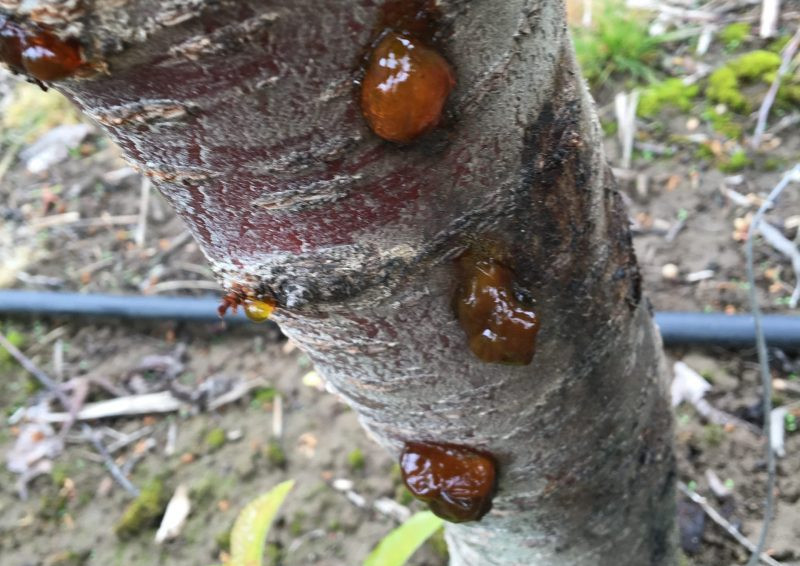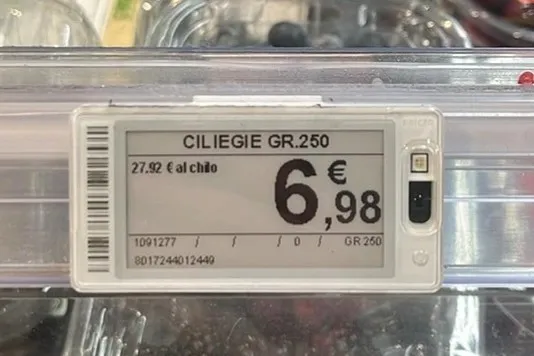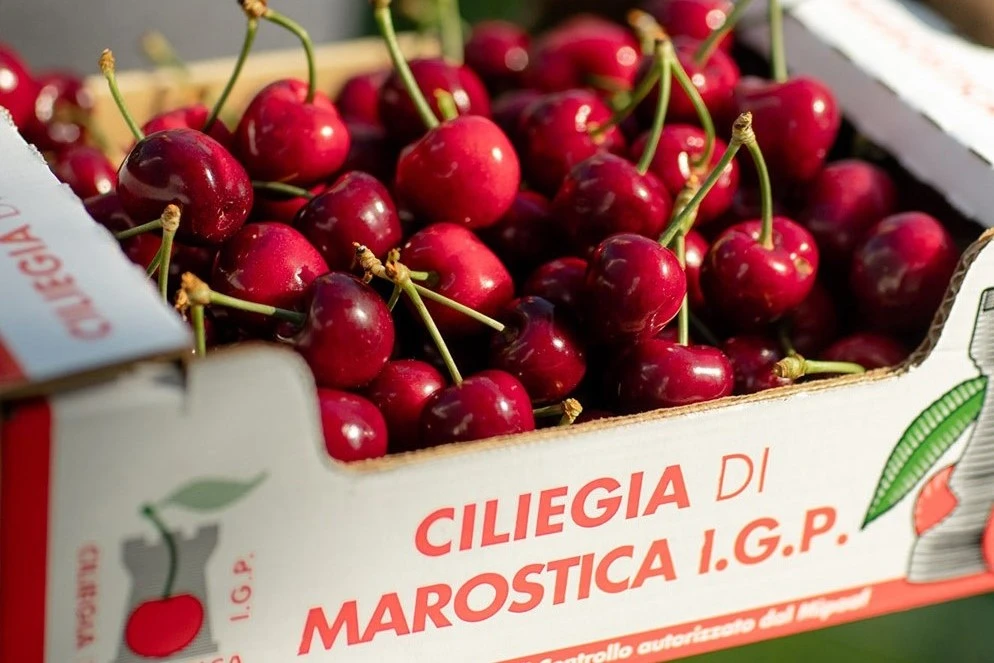In the last decade, cultivation of the sweet cherry (Prunus avium L.) has gained particular commercial interest, thanks to the profitability associated with exporting cherries out of season to Asian countries and the United States. The national industry is expanding and adapting to the demands of the global market, prioritizing sustainability and production efficiency.
In recent years, the cultivated area of cherries in Chile has increased significantly, with 63,495 hectares distributed between Coquimbo and Aysén, with the highest concentration in the regions of O'Higgins and Maule (ODEPA, 2024).
It is widely acknowledged that bacterial canker is the most limiting phytosanitary factor in various sweet cherry cultivation conditions. Caused by Pseudomonas syringae pv. syringae (Pss), this disease can lead to the death of young cherry trees and cause significant losses in the productive potential of mature trees affected by the disease.
The pathological situation worsens in cultivars with higher susceptibility and in locations where cold springs and frosts prevail, along with intense winds and frequent humidity such as drizzle and prolonged dew, climatic conditions common in the southern part of the country.
It is also important to consider the genetic variability in Pss populations in Chile, in terms of virulence and copper resistance. Given the complexity of this bacterium's pathogenesis, integrated disease management is essential, and in this context, biocontrol can be a suitable option to reduce the prevalence of this serious cherry disease.
Etiology and Control Methods
Bacterial canker of cherry trees is caused by Pss, a bacterium that causes diseases in a plethora of cultivated, ornamental, and wild plants. In 2019, Pseudomonas amygdali pv morsprunorum (Pam) (previously known as Pseudomonas syringae pv morsprunorum) was also reported to be associated with cherry bacterial canker (SAG, 2019).
In the context of this new situation regarding the causality of cherry bacterial canker in Chile, literature indicates the occurrence of a synergistic interaction between Pss and Pam (Balaž et al., 2016; Iličić et al., 2021) that needs to be clarified and investigated in Chile.
The prevalence of cherry bacterial canker shows wide variability, influenced by specific agroclimatic conditions and crop management practices. This variability is observed both in terms of incidence (ranging from 1% to over 30%) and in the intensity of symptoms in different locations and cultivars; young trees are the most susceptible, with a high probability of dying within the first three years after infection.
This context underscores the importance of adopting preventive management and control strategies, especially in the early stages of cherry tree development.
As known, control of cherry bacterial canker is usually carried out with preventive applications of copper at leaf fall and bud break; its effectiveness is based on the release rate of the Cu+2 ion, water pH, particle size, and copper formulation (e.g., basic copper sulfate, copper sulfate, copper oxychloride, copper oxide, copper pentahydrate sulfate, copper hydroxide, copper gluconate).
Its residual activity and broad-spectrum control of bacterial diseases are due to the fact that, once sprayed on plants, it is released over an extended period, interrupting the cellular multiplication processes of Pss.
Frequent application of copper can pose toxicity risks to the plant, decrease bacterial species in the microbiome, and lead to the predominance of copper-resistant Pss populations; its accumulation in the soil, phytotoxicity, and toxicity to various beneficial organisms have also been demonstrated (Beltrán et al., 2021; Carroll et al., 2010).
 Image 1. Source: WSU.
Image 1. Source: WSU.
Biocontrol Agents
There is growing interest in using biocontrol agents as a sustainable alternative to suppress or inhibit the growth of various plant pathogens, including Pss. These products are derived from natural sources such as microorganisms (bacteria, fungi), plants (essential oils and other derivatives), and bacteriophages (bacterial viruses).
The mechanisms of action related to the activity of biocontrol fungi and bacteria can operate through a direct antagonistic effect on the plant pathogen, which includes antibiosis, parasitism, reduction of pathogen virulence, and competitive pressure on the infection. Indirect mechanisms include inducing resistance and stimulating plant growth.
Bacillus subtilis and B. amyloliquefaciens are Gram-positive bacteria known for their remarkable ability to produce various antimicrobial compounds against plant pathogens. These bacteria have been shown to colonize the rhizosphere, establish symbiotic relationships, and induce defense responses in plants against plant pathogen attacks.
The secretion of antimicrobial compounds by Bacillus strains inhibits the growth and development of harmful microorganisms in the soil or on plant surfaces.
This biocontrol strategy can significantly reduce the incidence and severity of bacterial diseases, as reported for Psa (Biondi et al., 2021). B. subtilis can effectively antagonize pathogens like Pseudomonas syringae by producing cytokinin, a key hormone in plant defense responses, and promoting disease resistance mechanisms.
Bacteriophages or Phages
Bacteriophages, or phages, are viruses that exclusively infect bacteria and are the most abundant biological entity on the planet. Present virtually throughout the biosphere, they possess vast genetic richness and morphological diversity (Suttle, 2005). The ICTV (International Committee on Taxonomy of Viruses) reports that there are about 165 species of phages capable of infecting bacteria of the genus Pseudomonas (Pseudomonas viruses).
Phages are potential candidates as biocontrol agents due to their ability to infect, replicate, and damage their host (bacteria), causing their death. They possess a high degree of specificity and have the ability to persist and proliferate in the environment (Buttimer et al., 2017; Rabie et al., 2020); in this regard, a study conducted in England showed that when phage strains are applied singly or in mixtures, they do not infect beneficial bacteria (Rabie et al., 2020).
The use of phages as biocontrol agents requires knowledge of their infection specificity and an understanding of how the host bacteria and phage, adapted to a specific pathogen, interact.
Studies with phages obtained from Chilean strains of Pss have demonstrated potential usefulness in reducing the epiphytic population of Pss during the bloom period (75% reduction in the population of a Pss strain) (Retamales et al., 2023), as well as in artificial infections in plants, where Pss symptoms did not reproduce (Higueras et al., 2023).
One of the limitations of using phages as biocontrol agents in cultivated species is their poor persistence in the phyllosphere due to factors such as UV rays, drying, temperature, pH, and some chemical molecules produced by plants (Buttimer et al., 2017); in this sense, phages contained in an adequate protective formulation can improve their adaptability and effectiveness by reducing the negative effects of the environment and the phyllosphere itself (Iriarte et al., 2007).
The literature indicates that the combination of phages and copper would not produce synergistic effects on some phytopathogenic bacteria, which can happen with antagonistic bacteria and defense inducers (Boulé et al., 2011; Buttimer et al., 2017; Obradovic et al., 2004). Research aims to generate further evidence of stability and control effectiveness in the field.
Essential Oils
Essential oils (EO) and plant extracts are known in alternative and traditional medicine for their antimicrobial activity (Cox et al., 2001), representing new bioactive compounds with reports of low environmental impact and phytotoxicity, as well as safety for human health (Satish et al., 1999).
EOs correspond to a mixture of complex volatile compounds, synthesized by secondary metabolic pathways in many plant species, particularly in aromatics (Bakkali et al., 2008); in nature, they play an important role in plant defense, acting as antimicrobials and signaling molecules to communicate with other plants and beneficial insects (Proto et al., 2022).
The specialized literature includes a variety of plants used to extract EOs, such as mint, thyme, oregano, clove, anise, orange, rosemary, garlic, eucalyptus, cumin, among many others. These plants are distinguished by the presence of high antibacterial potential molecules such as thymol, carvacrol, and/or eugenol, among others.
The potential of EOs as a sustainable natural alternative for diseases caused by Pseudomonas syringae, such as bacterial blight and leaf spots in crops (Gholam, 2011; Lo Cantore et al., 2003; Poswal & Witbooi, 1997; Todorovic et al., 2016), has also been highlighted; moreover, some EOs have shown the ability to inhibit bacterial multiplication, biofilm formation, and motility of Pseudomonas syringae isolates obtained from soy (Carezzano et al., 2023).
The volatility and instability of EOs pose technical challenges for their proper field application, which can be addressed through encapsulation to improve preservation and protection from environmental factors, thus expanding application possibilities (Osimani et al., 2022); despite these limitations, EOs are a promising option as biocontrols and agents to combat antimicrobial resistance.
Efficacy of Biocontrol Agents in Cherry Trees
Researchers at the Plant Pathology Laboratory of Universidad de O'Higgins evaluated the efficacy of three biocontrol agents on the prevalence of leaf necrosis caused by Pss in young cherry plants of the Santina/Colt cultivar, maintained under semi-controlled conditions. The trial was conducted through artificial inoculation of an aqueous suspension with a virulent strain of Pss adjusted to a concentration of 107 CFU/mL. The treatments were:
- Boldo essential oil applied 16 hours after inoculation with Pss at a concentration of 1000 ppm;
- a mixture of phages (unformulated; 108 PFU/mL) obtained from Chilean strains of Pss and applied 16 hours before inoculation with Pss;
- experimental biostimulant (2 cc/L) with 2 applications pre-inoculation + 2 applications post-inoculation with Pss. Positive and negative controls were "only Pss" and copper oxychloride (1.5 g/L), respectively.
About 30 days after the inoculation with Pss, all treatments and controls in the experiment showed symptoms, with differences in their expression. It was determined that treatments with biostimulant and boldo essential oil significantly reduced the incidence of necrotic lesions on cherry leaves compared to the positive control (approximately 20-30%).
It was also demonstrated that treatments with biostimulant and boldo essential oil were significantly effective in reducing the severity of lesions caused by Pss (affected area/total area x 100) compared to the positive control (only Pss), which did not differ significantly from the negative control (copper). See graphs 1 and 2.
The integrated management of bacterial canker in cherry trees requires a combination of strategies to be effective and sustainable over time.
In this context, biocontrol agents represent a valid alternative to reduce dependence on traditional antimicrobials and their negative effects. In this regard, our study demonstrates that the use of boldo essential oil and the biostimulant treatment can significantly reduce the incidence and severity of the disease caused by Pss, especially in young cherry trees.
It is pertinent to note that the severe prevalence of bacterial canker in southern Chile, compared to other cultivation conditions worldwide, is an aspect that requires extensive, systematic studies of greater complexity, both in terms of the genetics of Pseudomonas syringae pv. syringae and the environmental factors that favor the development of this bacterium, as well as the preventive and curative control strategies, in accordance with the needs of environmental protection, in a context of accelerated global and local climate change.
Source: Mundoagro
Image: Mundoagro
Cherry Times - All rights reserved













